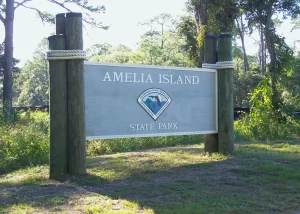Para leer en español oprime aquí.
Without a doubt we can say that one of the most unusual episodes in the history between Spain and the United States is related to the famous Amelia Island and the creation of the “Republic of Florida.”
The Sunshine State was first encountered by the Spanish when explorer and conqueror Juan Ponce de León reached its shores on March 27, 1513. He finally walked on land on April 8 on the same date as when Spain celebrated “Día de la Pascua Florida” (Easter Sunday), which is how Ponce de León decided to name this place “Florida.”

Sign at the Amelia Island State Park
Spanish Florida was made up of so-called “Eastern Florida,” which comprises practically the entirety of Florida today, and “Western Florida,” which refers to the strip of land on the Gulf Coast of the Florida panhandle, Alabama, Mississippi, and Louisiana to the Mississippi River.
Amelia Island (once also Amalia Island) is located on the east coast of Florida separated from the mainland by a very short distance, and where at its northern end are the mouths of the Cumberland, Amelia, and the St Marys rivers, which served as the border line between Spanish Florida and the United States. In this port, it is documented that frigates with 36 to 40 guns could be docked or anchored.
This was a strategic point of observation of incoming ships from the North or South, and together with the port of St. Augustine, they were fundamental bases for the future consolidation of the Kingdom of Spain in the area.
But in addition to Spain, this island became a site of high interest for the United States government, pirates, and independence groups from South America and New Spain (now Mexico).
No one could have imagined that, during the course of one year, 1817, the island would be handed to four different owners. At first, there was the kingdom of Spain, who claimed the island and took possession of it. Then an expedition of the Scottish general Gregor McGregor, who fought for the independence of Venezuela and who, later, under the orders of Simón Bolívar (although there are documents that say otherwise), took the island thanks to the funds he was able to obtain in Savannah, Charleston, New York, Philadelphia and Baltimore and to the force of men that he recruited within American territory. McGregor created the Republic of Florida where he hoisted his new flag that had a white background with the green cross of St. George from June 29th to June 4th September 1817.

Flag of the Republic of Florida in 1817
Later, the French general Louis Aury disembarked on Amelia Island and took possession of the island on behalf of Mexico. In this venture, he was accompanied by the Venezuelan lawyer Pedro Gual and the Peruvian priest Vicente Pazos Kanki who drew up a constitution, decreed freedom of the press and religion, and called elections.
In addition to the situation occurring on the island, privateers began to move freely, and thus negotiations between the USA and Spain began. This had generated much concern in the American government, and, therefore, the U.S. made the decision to take over the island since it, like all of Florida, was a matter of high interest to the United States.
The Florida negotiations between the Kingdom of Spain and the United States concluded with the signing of the Adams-Onís Treaty, which title was: “Treaty of friendship, settlement of differences and limits between His Majesty and the United States of America.” It was signed on February 22, 1819 in Washington and ratified by the Spanish King in March 1821.
By Dr. Carlos G. Cruz H.
Corresponding Member of the National Academy of History, Venezuela.
Corresponding Member of the Venezuelan Academy of Language, Corresponding to the Royal Academy of the Spanish language (RAE).





